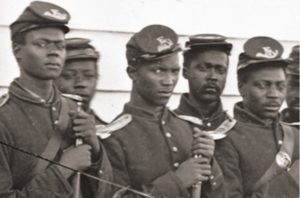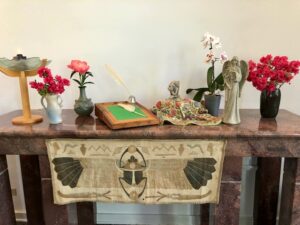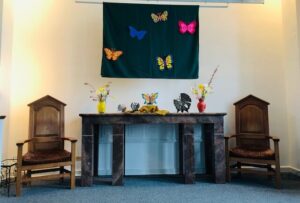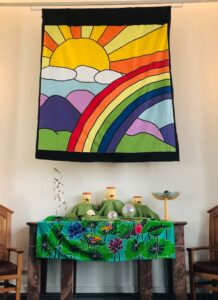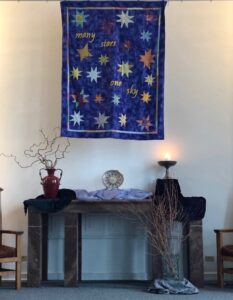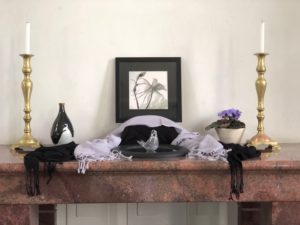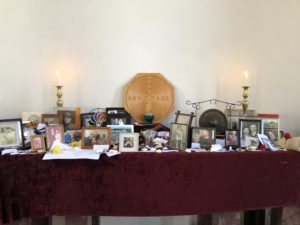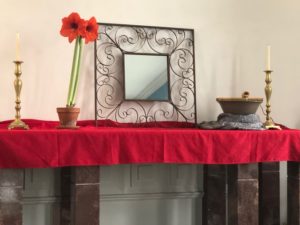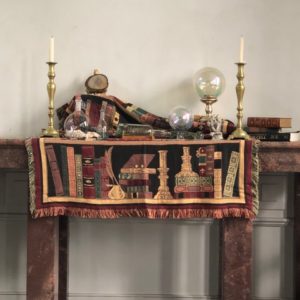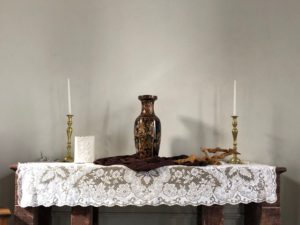In April of 1865, at the end of the Civil War, Union troops entered the city of Charleston, S.C. A great many of the white residents of Charleston had left the city in advance of the soldiers, but the Black citizens remained, welcoming the troops to the city where it had all begun four years earlier. Among those troops was the 21st Colored Infantry (later joined by the 54th Massachusetts and the 34th and 104th United States Colored Troops).
Near the war’s end, the Confederacy had erected a makeshift prison for Union soldiers in what had been the Washington Race Course and Jockey Club. The conditions were horrendous, and it is recorded that 257 of them died of disease, all hastily buried in a mass grave. David Blight, a history professor at Yale, discovered archival records which showed that in April of ‘65, Black workmen from Charleston disinterred the remains of those soldiers, re-buried them with proper respect, and then built a tall fence around this new cemetery. On its archway entrance they placed a sign that read, “Martyrs of the Race Track.”
According to the records Blight found, including a contemporary report from the New York Tribune, on May 1st they dedicated this cemetery. 10,000 people paraded along that racetrack in what the correspondent called, “a procession of friends and mourners as South Carolina and the United States never saw before.” (I’m going to quote the rest of this from an article Bob Gross originally pointed me toward)
The procession was led by 3,000 black schoolchildren carrying armloads of roses and singing the Union marching song “John Brown’s Body.” Several hundred black women followed with baskets of flowers, wreaths and crosses. Then came black men marching in cadence, followed by contingents of Union infantrymen. Within the cemetery enclosure a black children’s choir sang “We’ll Rally Around the Flag,” the “Star-Spangled Banner” and spirituals before a series of black ministers read from the Bible.
After all this pomp, this “Decoration Day” continued on much as Memorial Day does today: picnics, speeches, and the enjoyment of a (hopefully) beautiful spring day.
Yet that’s not a story that most folks in the U.S. know. Most of us – perhaps particularly those of us who identify, or are identified, as white – probably learned a different origin for Memorial Day (although I’d wager few of us actually remember the lesson).
On May 5, 1868, three years after the Civil War ended, the head of an organization of Union veterans, Maj. Gen. John A. Logan, established Decoration Day as a time for the nation to decorate the graves of the more than 620,000 soldiers who died during the war, “whose bodies,” he wrote, “now lie in almost every city, village and hamlet churchyard in the land.” He said that Decoration Day, as he called it, should be observed each year on May 30. It is believed that date was chosen because by the end of May flowers be in bloom pretty much all over the country (although there is the alternative explanation that he chose the date because it wasn’t the anniversary of any battle fought during the war).
That first “official” Declaration Day was celebrated in more than 27 states, with more than 5,000 people at Arlington National Cemetery alone. By 1890, every state that had found on the Union side celebrated Declaration Day on May 30th. For more than 50 years, however, so, until 1918, the holiday was dedicated just to those who’d died in the Civil War. It wasn’t until we entered World War I that it came remember those who’d died in all of our wars, and it didn’t wasn’t until the ‘70s, in the midst of the Vietnam War, that it became an official holiday across the U.S.
In 1968, the date of Memorial Day, as it was by then called, was changed from May 30th – regardless of what day of the week that was – to where it is now, the last Monday in May. Ever since, though, there has been opposition to this change, with some veterans’ groups worrying that doing this just turned it a three-day weekend and the signal for the start of summer. Even as recently as 2012 when he died, Senator Daniel Inouye reintroduced a bill each year to put Memorial Day back where it used to be on our calendar and, hopeful, back to what it was meant to be in our national psyche.
Boalsburg, Pennsylvania claims to have been the first place to celebrate a “Declaration Day” in 1864 when a there was a gathering of women to mourn those who’d recently died at Gettysburg. Carbondale, Illinois argues that it’s the birthplace of today’s Memorial Day because of a parade John Logan led there in 1866. There’s a city in Mississippi, and one in Georgia which also claim to be first, and, as we’ve just heard, Charleston, South Carolina is also in the running as to the place where it all began. Congress, however, attempted to definitively settle the matter when, in 1966, it declared Waterloo, New York as the birthplace of Memorial Day.
Do you remember how, a few weeks back, I told the story of the origins of Mother’s Day, which either began with Anna Jarvis’ mother, Ann, or with Julia Ward Howe’s called for a Mother’s Day for Peace? Here we see that again, competing narratives which claim to tell the story of “What Happened.” In other words, competing histories.
“History is written by the victors,” Winston Churchill famously said, and this is a sentiment that you hear time and time again. The reason that our nation’s history, for instance, has been told overwhelmingly from the perspective of straight, white, cis-male folks of means is that straight, white, cis-mail folks of means have held the power to write the history that would “stick.”
And yet it’s not entirely true that only “victors” write history. “The victors,” as it were, get to write the “official” history, but we have the journals and other writings of some of the estimated roughly 3.9 million enslaved people who formed the foundation of this country (even those these writings were only relatively recently “discovered”). Women have always written about their experiences, even when no one else would listen. (The #MeToo movementis not the first time women have told the story of how pervasive sexual harassment, abuse, and assault is in the dominant rape culture. It’s just the first time they’re stories are being heard in the mainstream.)
In fact, those who have been marginalized, disenfranchised, have always found ways to remember and tell their stories. Those stories, though, have almost universally been drowned out by the dominant narrative. More and more, though, these long-segregated histories are being told in the mainstream, and the dominant history, the one written by the victors, is being seen as missing something vital. Do you remember how after the Smithsonian’s National Museum of African American History and Culture opened a few years ago, there was a huge backlash? People were calling it out for that mythical crime of “reverse-racism,” because the museum was telling the history only of African Americans. I remember hearing a white man being interviewed after coming out from the museum, asked what he thought about that critique. He said, and I’m paraphrasing, “This is my history, too, as a white American, as an American. It’s a part of the history I’d never heard before, a part lots of people would rather not see and hear, but it’s part of the whole history of this country.”
More and more these other stories, these other histories, are being heard by the mainstream, yet they’ve always been told. And as these stories are coming to a more widespread consciousness, those of us who’ve known little, or nothing, but the dominant history are being faced with the need to recognize that there is more than one way to experience something, more than one way to remember something, more than one “history,” if you will, of events.
This doesn’t just happen on the national scale, either. A couple of months ago my oldest brother retired after 30 years. My family and I attended his retirement party, and our middle brother went down for the weekend too. A few of us were sitting around the table at some point, and somehow the conversation turned to who’d had surgery and why. (Not really all that unusual for the Wikstrom boys, actually.) Pat, the oldest, said that he could remember when I’d had my tonsils out and what a traumatic experience it’d been for me. He said that my recovery was really rough; he could remember it so clearly. I said that, actually, I’d never had a tonsillectomy, and our middle brother, Paul, joined in, saying that he’d been the one who’d had that operation and the difficult recovery Pat remembered.
Another time we were talking about our parents, and the time my mom and dad separated. I had no memory of this at all. Paul said that it had been for a few weeks. Pat said that it’d been for a few months. We each had a different story to tell about our parents. We each carry a different understanding of history, even though in many ways you’d think it was a shared history.
Life is hard. Life can be really hard. And relationships can be really hard. I once heard someone somewhere say, “If you’ve never been betrayed, wait a while.” In the first church I served – during my first year, as I remember – I got a phone call from a man who had once been tremendously active in the congregation but who had, for years, completely cut it, and everyone, off. I’d heard about him, and people’s wondering why had had made such a decisive break, so I was surprised to hear from him with a request that I visit. I went to his house that afternoon.
He told me that he was in real turmoil, and just didn’t know what to do. He had, as I said, been really active. He had been on every committee – most more than once – and was involved with pretty much everything you could be involved in. (He said that he’d been a part of everything but the Women’s Alliance.) When his mother died, though, not one person sent a condolence card. Not one simple person cared enough about him, apparently, to do such a simple thing. And, so, he left the congregation and never looked back. This man had held on to this hurt, this sense of betrayal for years. After all he’d done …
Earlier in the day that he’d called me, he said, his sister had called him. She was moving out of her home of many years, and was packing things up. “What do you want me to do with this box that I found in the attic?” she asked. “It’s filled with all those cards your congregation had sent after mom died.” It turns out that people had reached out. Everyone had sent a card. As the custom was in that time and place, they’d sent their cards to the funeral home, and after the service the funeral director had accidentally given the box to his sister instead of to him. She apparently hadn’t really thought anything about it, and put the box away in the attic.
“What am I supposed to do now?” he asked me. He said that he’d judged and condemned all those people for all those years, and had just now come to learn that the story he’d told himself, the history he’d known all those years, wasn’t true.
I’ve seen this over and over again. You may well have too, if not in your own life then in the lives of those around you. Long-running feuds between old friends; siblings who’ve turned their backs on one another; parents and children estranged from one another; all because each has a memory, a sense of their history, that’s different than the other.
I want to be clear here. I want to be very clear, so please listen. I am not saying that, for instance, someone who has a painful, traumatic memory from their past is “wrong” even if others remember things differently. I’m not saying that at all. Often, in fact, the stories, the history we know about the wounds that have been inflicted on us by others in our lives are contradicted by those very people. I am not saying that those who have been abused, for instance, need to give equal weight, or even credence, to the stories our abusers tell of “what happened.” That’s not what I’m saying.
I am saying, though, that it can be important for us to remember, when we find ourselves in conflict with someone else, that they may be operating from within a sense of history that is different from, and perhaps even contradiction to, the history which we know. When this happens, the conflict we’re having may well not be about the specific incident (or incidents) that we think it is; it may actually be about the fact that we don’t share the same history, even if we both lived through the same events. In cases like that, the only way to resolve the issue is for each to listen to the other; to accept that we do, in fact, often interpret the same thing in different ways, and to try to come to a better understanding, together, of the experiences we have shared. To see the world through the eyes of another is to expand our own understanding of the history of our lives, and to come fully into that “truth and meaning” we Unitarian Universalists are committed to seeking out.
The 21st Colored Infantry along with the 54th Massachusetts and the 34th and 104th United States Colored Troops
held a celebration on May 1, 1865, the first “Decoration Day,” which later became Memorial Day

